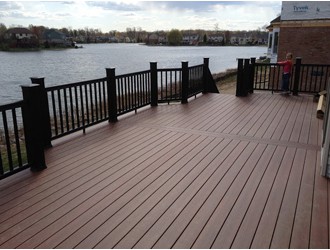A number of Chinese WPC makers, who use bamboo as the only filler of the composite, today offer a BPC (bamboo plastic composite). In the majority of cases BPC is yet explained as WPC filled with bamboo powder. In some case you'll be offered a bamboo plastic composite as being somewhat different from WPC, not in the names alone, but rather in product properties. Those manufacturers who offer either wood flour or bamboo powder as a filler, in most cases would prefer using WPC name for their lumber.
There are makers who use plant fibers, such as oil palm, coconut husk or coir and others in their plastic composites. These fibers have a real reinforcing effect as compared with wood flour which is not considered to be a really reinforcing filler. These makers market their composites as FRPs (shortened from fiber reinforced plastic). Originally FRP served as a common definition for thermoset polymers (epoxy, polyether) or phenolformaldehyde resin reinforced with inorganic fibers (glass fiber, carbon, aramid). Although reinforcing effect is there, to our point of view, consumers' perception of the term has already been formed exactly in the context of used thermosets and reinforcing fillers. Due to this reason we wouldn't use FRP abbreviation explaining cellulose-based plastic composite. A modified version, that some players actually use, is NFRP (natural fiber reinforced plastics) seems to be a better option.
Another WPC reinforcing filler is kenaf that shows much better reinforcing properties as compared to wood. As soon as researches already use GKC (ground kenaf core) abbreviations, in the future we likely to see KPC or GKPC terms defining WPC filled with kenaf powder.
So, today we're witnessing a trend of utilization of new names for lignocellulosic plastic composites, along with or instead of WPC. Strictly speaking, such names are more precise by definition. Besides, despite of similar chemical structure and composition, specific lignocellulosic fibers, bamboo fiber among others, are capable to enable plastic composite with improved physical or aesthetic properties, as compared to wood. Thus, principally they have the right to be addressed independently from wood.
Widespread awareness and utilization of English "WPC" abbreviation in its unchanged form in many languages keep most of non-wood filled WPC makers from not using the term completely.
It's not so long ago that WPCs were only put in contrast with natural wood, plastic, metal and other materials. Today we observe the rivalry inside «lignocellulosic family», because the rules of the game are set by the market. As competition grows, non-wood WPC manufacturers will not employ the name of fibers they use simply trying to be precise in naming of their composites. Rather they will be using this as an opportunity to differentiate their non-wood filled composites against WPC, focusing on the benefits their specific fiber brings, as compared to wood.
Product differentiation is somewhat inevitable. Recently even conventional wood-fiber based WPC lumber makers are forced to match their lumber products against each other. Today an advanced WPC manufacturer will offer you traditional WPC, capped WPC, heavy-duty WPC and some «super-brand» WPC, with the latter being the best WPC ever.




